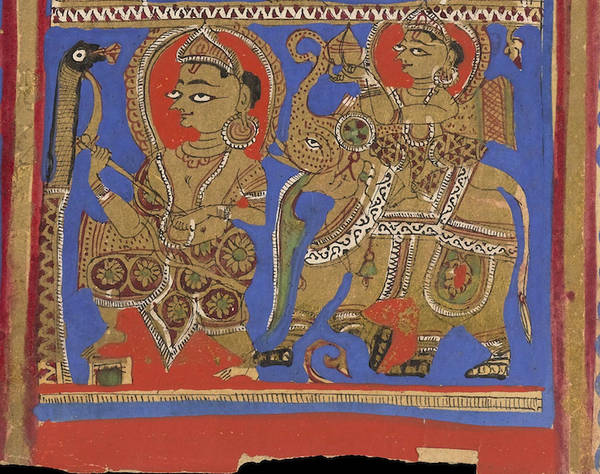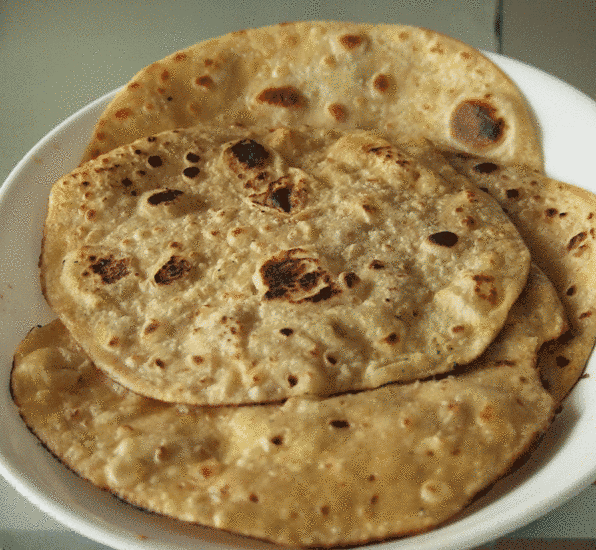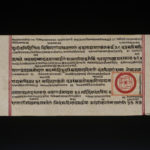Article: Non-violence
One of the fundamental Jain values is ahiṃsā – ‘non-violence’ or ‘non-harm’. It underlies religious practices for both mendicants and lay people and is found throughout Jain doctrine. This explains why for many contemporary Jains their religion can be expressed in a simple maxim, namely:
Ahiṃsā paramo dharmaḥ
Non-violence is the highest religious duty.
Although the English phrase ‘non-violence’ can be understood as an absence of violence, in Jain belief ahiṃsā has a much more active dimension. Among contemporary Jains, ahiṃsā has been interpreted to include activism in matters such as peace, the environment, animal welfare and alleviation of poverty.
Ahiṃsā is closely associated with key religious concepts such as the soul, karma, the cycle of birth and cosmology. Attachment to the world and the activities that arise from it, even everyday living, create karmas that bind the soul in the cycle of births. All living beings have a soul – jīva – which is reborn in different bodies and conditions according to the karma it generates. Violence – hiṃsā – especially deliberate, extreme violence such as murder, creates powerful negative karma that result in the soul’s rebirth as a plant, two-sensed being or even an infernal being. Non-violence thus reduces the production of negative karmas, thereby helping the soul progress towards liberation, which is the ultimate aim of Jainism.
As one of the principal Jain teachings, ahiṃsā is stressed throughout Jain literature. Tales of the lives of the Jinas, leaders of the Jain faith, often include episodes of ahiṃsā to inspire Jains to practise non-violence.
Violence may be intentional or committed through error or carelessness. Jains believe that unintentional violence is an inevitable part of everyday life, as merely eating, drinking and washing harm the tiny ekendriyas that are found in water, fire and all parts of the universe. However, followers of the Jinas can go some way to limiting the violence they commit.
The best way to reduce violence, both accidental and deliberate, is to become a mendicant. As part of their initiation, monks and nuns take the five māha-vratas, the ‘fundamental vows’ that express the key moral principles of the faith. The first of these is ahiṃsā. Throughout their lives, Jain mendicants strive to reduce the violence that living entails by following rules designed to improve self-awareness, self-control and carefulness. Observing these rules minimises inadvertent violence.
Lay people cannot perform non-violence to the same degree as mendicants because daily living involves unintentional injury to other souls. However, they can practise self-control and carefulness, taking care to avoid violence and prevent it where possible.
All Jains are vegetarian, as this diet lessens harm to other living beings. There are numerous rules on what foods are suitable, which differ in the various sects. Mendicants are subject to stricter rules than lay people, who may not observe all the traditional regulations nowadays.
A common public demonstration of ahiṃsā in practice is the institution of the animal hospital. Jains frequently set up sanctuaries for sick and injured animals as an expression of ahiṃsā in the wider sense of caring for living beings.
This piece is a summary of the article "Non-violence". The full article will be available soon.
Definition
The Sanskrit term ahiṃsā is normally translated into English as ‘non-violence’, and is frequently thought of as ‘not being deliberately violent’ or ‘peaceful’. The Jain concept is more accurately understood as meaning:
- ‘doing no harm, whether deliberate or accidental’
- trying to actively protect living beings by restraining one’s behaviour.
In more recent times, it has been interpreted more widely to include friendship and goodwill towards all living beings.
Effects of violence
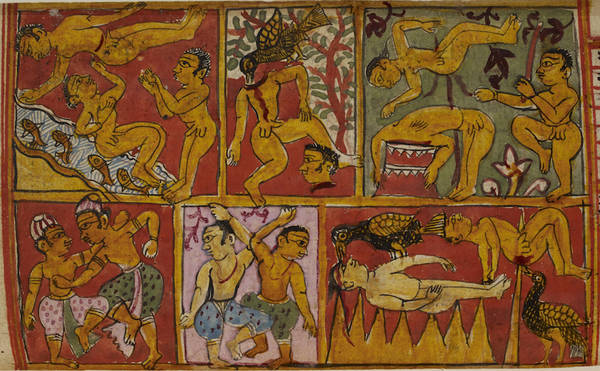
Tormented souls
Image by British Library © CC0 1.0 (Creative Commons Public Domain)
Violence – hiṃsā – can be performed in thought, word and deed and can be deliberate or accidental. The effects of violence on others can be very damaging, such as pain, injury or death. Jains believe that acting, speaking or thinking violently is also very detrimental to the soul. Ahiṃsā is therefore closely associated with fundamental Jain beliefs regarding the soul, karma and the cycle of birth.
The liberation of the soul or self – jīva – is the objective of the Jain faith. The soul is born into a physical body, lives and dies, and is then reborn into another body in a perpetual cycle of birth – saṃsāra. The soul is trapped within saṃsāra by the karmas attached to it and can only break out when it is free of all karmas. The type of body – gati – into which the soul is embodied depends on certain karmas it has gathered during its previous lifetimes.
All the various types of karmas are generated by activities, which can broadly be divided into good or bad, with good actions following Jain principles while bad actions go against them. Good conduct generates positive karmas – puṇya-prakṛtis – while bad behaviour produces negative karmas – pāpa-prakṛtis. Positive karmas cause the soul to be born into a desirable condition, such as human being, deity or intelligent animal. Negative karmas result in births of low spirituality, such as insects, worms, plants or beings in hell. These conditions of birth often have little or no capacity for reason, which makes it very hard to progress spiritually towards liberation. The worst kind of karma, with the severest result, comes from committing extreme violence that is deliberately intended – hiṃsā. Even accidental violence creates negative karmas, which corrupt the soul and trap it within the cycle of births.
Therefore Jains must not be violent because:
- all living things have souls, which must be cherished and protected
- violence harms the soul of whoever commits it.
The Jain attitude of non-harm and protection extends to all forms of life because Jains recognise the value of the soul within each living creature, no matter how simple and lowly. The life and wellbeing of the soul of a tiny ant are as precious as that of a human being or a god. In Jain belief all life is intimately connected, with all souls striving to gain liberation.
Scriptures
The centrality of non-violence – ahiṃsā – is emphasised throughout Jain holy writings.
For example, the earliest treatise on mendicant behaviour in the Śvetāmbara canon states:
‘all breathing, existing, living, sentient creatures should not be slain, nor treated with violence, nor abused, nor tormented, nor driven away. This is the pure, unchangeable, eternal law which the clever ones, who understand the world, have proclaimed.
Ācārānga-sūtra, 1.4.1.1–2
translation by Jacobi
The fundamental religious text of all sects, the Tattvārtha-sūtra, stresses that careless actions can kill or harm life.
Jinas and non-violence
The 24 Jinas exemplify religious conduct, including non-violent behaviour, in the accounts of their lives. Examples from the biographies of two of the most popular Jinas demonstrate that Jains should not just avoid doing harm themselves but also actively stop violence towards other living beings.
The most famous such example is Neminātha or Lord Nemi, the 22nd Jina. The young man reluctantly agrees to marry Princess Rājīmati, even though he is dissatisfied with secular life. On his way to his wedding, Nemi sees distressed animals crowded in pens and is horrified to learn they are to be slaughtered for his wedding feast. The prince immediately turns back, calling off the wedding, and decides to be initiated as a mendicant instead of marrying and causing so much pain and death.
The second instance is found in the life story of the 23rd Jina, Pārśvanātha or Lord Pārśva. While watching an ascetic perform the penance of the five fires, Prince Pārśva becomes aware of a snake trapped in a burning log. As a spiritually advanced person, the prince has clairvoyant powers and thus knows the snake’s pain and fear. The prince asks his servant to split open the wood and free the snake.
Practising ahiṃsā
The concept of ahiṃsā – non-violence – underlies the other principal Jain beliefs and is the foundation of religious practices. There are four main ways in which Jains can observe ahiṃsā.
Taking a vow to practise ahiṃsā, especially the ‘fundamental vow’, is one way. This is linked to the second method, which is becoming a mendicant, partly because the mendicant lifestyle is regulated by rules that help minimise accidental violence. Mindfulness and self-control are virtues that all Jains can practise, whether mendicant or lay, as is a diet that reduces violence against living beings.
Mendicancy
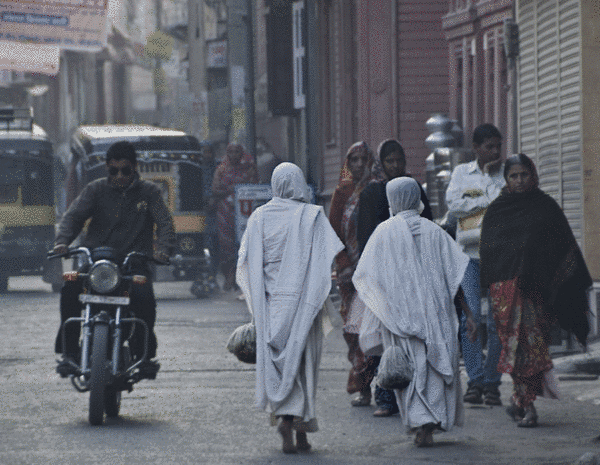
Nuns walk down the street
Image by Eric Parker © CC BY-NC 2.0
Jainism states that becoming a mendicant is the best path to liberation. Jain monks and nuns withdraw from life in the world and make religious duties and renunciation the centre of their lives. Mendicancy therefore reduces the amount of karma generated from activities related to living and burns off accrued karmas through asceticism.
Lay people who decide to become mendicants take a vow of non-violence as the first of their five māha-vratas, the vows that all monks and nuns take as part of their initiation. As key elements in becoming a monk or nun, the māha-vratas are ‘absolute’ and must be observed at all times. All the māha-vratas or mendicant vows are threefold, because Jain principles can be broken in three ways. Thus mendicants promise to observe their vow of non-violence in thought, word and deed.
Many of the rules that order the mendicant life relate to avoiding carelessness, which may cause unforeseen injury to living beings. This is especially the case with the sub-microscopic nigodas and the tiny one-sensed life-forms – ekendriyas – that cannot be seen with the naked eye and live throughout the universe. For example, mendicants do not use water unnecessarily and drink only water that has been properly boiled to minimise harm to water-bodied beings. Another example of minimising accidental violence is the monastic broom – rajoharaṇa – which all mendicants carry. They use their brooms to gently sweep surfaces before they sit or lie down, so that they do not harm invisible life-forms in error. The most noticeable instance of trying to stop accidentally hurting ekendriyas is the mouth-cloth worn by mendicants in two sects in the Śvetāmbara tradition – the mukhavastrikā or muṃhpatti. This was a practice that deeply struck European travellers from the 16th century onwards. Monks and nuns in the Terāpanth and Sthānaka-vāsin sects wear mouth-cloths all the time to avoid harming air-bodied beings by breathing and speaking.
However, the best known-example of the practise of non-violence – ahiṃsā – among monks and nuns is the daily or twice-daily ceremony of alms-gathering. Monks and nuns are forbidden from obtaining and cooking food because of the level of violence required, and must seek alms from lay Jains. Even though inadvertent violence is accepted as part of everyday life for householders, lay Jains can gain good karma by offering alms correctly to mendicants.
Vows
The vows of Jain mendicants and lay people begin with ahiṃsā, which is the first of the five ‘fundamental vows’. Set out by Māhavīra, the last Jina of the present age, these vows underscore the main moral principles of the Jain faith and keeping them is thus intended to promote spiritual progress. Formal, public vows are key parts of religious practice but private resolutions may be just as binding and challenging.
The vow of non-harm has three elements. The person making the vow promises not to:
- hurt other living beings with body, mind or speech – kṛta
- cause harm to others – kārita
- approve of harmful actions – anumodana.
For Jain monks and nuns, the vow of non-violence is lifelong and ‘absolute’. They follow strict rules designed to help them observe this vow and their other vows and duties.
Lay people can take the ‘lesser vows’ – aṇu-vratas – which they can observe during their lives as householders, while carrying out duties to family and community. Jain texts have always accepted that the lay lifestyle involves some degree of violence, because lay people require food, clothing, housing, work and so on, and must do all kinds of activity just to live. The lay vow of non-violence is much more restricted than the mendicant version, and only applies to harming beings with two or more senses. In addition, many lay Jains try to minimise their direct and indirect involvement in violence, for example by avoiding jobs and activities that entail great harm, such as mining.
Jain thought recognises degrees of non-violence and the texts allow lay people to commit accidental – or even deliberate – violence if greater harm will come from not doing so. An example would be someone deliberately committing violent acts to protect others from violence, which is accepted as the lesser of two evils.
Self-control and carefulness
Many of the mendicant rules aim to cultivate mindfulness and self-control – saṃyama. Being constantly aware of one’s actions and thoughts is a way of controlling and eventually eliminating attachment and thus karmas. It also reduces inadvertent harm, such as treading on insects while unaware of one’s surroundings. It is therefore a method of advancing spiritually, and is thus a very valuable element of the route to liberation.
Monks and nuns strive to achieve complete self-awareness and self-control, showing carefulness and restraint in all aspects of their lives. However, all Jains can practise these virtues. If lay people are aware of all the repercussions of their actions and practise self-control, this helps to both:
Traditional vegetarian diet
All Jains uphold the principle of non-violence – ahiṃsā – by being vegetarian. Since Jains believe that all life forms, including plants, contain soul – jīva – they accept that killing embodied souls just to eat is inevitable to some degree. Despite this, they minimise violence by following a strict vegetarian or vegan diet according to religious guidance. The purity of food is a key concern for mendicants in particular, but is important for all Jains. However, lists of forbidden foods in scripture and other texts vary by sect.
Jains must never eat any kinds of meat and fish, including the flesh of any animal that has died of natural causes. Fermented, decaying or moist foods, such as alcohol, are forbidden because they are breeding grounds for nigodas. Eggs and honey are not permitted. Certain fruits and vegetables that contain many seeds, and thus potential souls, are not allowed. Examples of such fruits are pomegranates and aubergines. Root vegetables and bulbs, such as carrots, garlic, onions and potatoes, are prohibited because they contain numerous souls. Every piece of a divided root or bulb can grow a new plant, which demonstrates that each root or bulb holds many souls.
In addition, Jains are not supposed to cook or eat after sunset – rātri-bhojana – because of the potential harm to other beings. For example, in the dark insects are attracted to cooking fires and may die in the flames.
Although dairy products are not forbidden in the traditional writings, veganism is spreading among contemporary Jains. Vegans avoid all kinds of food and drink from animals, such as milk and yoghurt. For Jain vegans, this is probably because of concerns about the treatment of cows in the dairy farming industry. Similar motives apply to eating organic foods, which are produced on farms without chemical pesticides and herbicides.
Some contemporary Jains always follow all the rules laid out in the writings of their sect, sometimes at great personal inconvenience. Some lay people observe the rules as much as is practicable in everyday life while others do so only on certain days or during festivals.
Jain mendicants must always stick to the stricter rules on their diets. They must carefully check all the meals offered to them as alms to ensure that it does not contain forbidden foods. Lay people are not supposed to prepare special food for monks and nuns, offering merely the food they would eat themselves. This means that, if the food is suitable for mendicants, lay Jains will therefore observe strict dietary rules themselves.
Animal sanctuaries

Bird hospital
Image by batschmidt © CC BY-NC 2.0
Actively practising the principle of ahiṃsā – non-harm – means that Jains are well known in India for establishing hospitals for injured, ill and old birds and animals. These are known as panjrapols or pinjrapols.
There is a long history across the subcontinent of the Jain community’s activities in animal welfare. Most Indian cities with Jain populations have an animal hospital or sanctuary funded by donations from local Jain organisations and individuals and from visitors. In these hospitals sick or injured animals, both pets and from the wild, are cared for, and old animals are looked after until they die.
Reading
- The History of Vegetarianism and Cow-Veneration in India
Ludwig Alsdorf - translated by Bal Patil
edited by Willem Bollée
Routledge Advances in Jaina Studies series; series editor Peter Flügel; volume 3
Routledge Curzon Press; London, UK; 2010
- Ahiṃsā: Violence et non-violence envers les animaux en Inde
Florence Burgat - Interventions series
Editions de la Maison des sciences de l'homme; Paris, France; 2014
- ‘Ahiṃsā – cur et quomodo?: Eine vierfache Antwort in einem alten Jaina-Text’
Colette Caillat - Berliner Indologische Studien
volume 18
Freie Universität Berlin; 2007
- The Jains
Paul Dundas - Library of Religious Beliefs and Practices series; series editor John Hinnels and Ninian Smart; volume 14
Routledge Curzon Press; London, UK; 2002
- The Jaina Path of Purification
Padmanabh S. Jaini - University of California Press; Berkeley, California USA; 1979
- Sacred Cows, Sacred Places: Origins and Survivals of Animal Homes in India
Deryck O. Lodrick - University of California Press; Berkeley and Los Angeles, California, USA and London, UK ; 1981
- Historical Dictionary of Jainism
Kristi L. Wiley - Historical Dictionaries of Religions, Philosophies, and Movements series; series editor Jon Woronoff; volume 53
Scarecrow Press; Maryland, USA; 2004
- ‘Ahimsa and Compassion in Jainism’
Kristi L. Wiley - Studies in Jaina History and Culture: Disputes and Dialogues
edited by Peter Flügel
Routledge Advances in Jaina Studies series; volume 1
Routledge Curzon Press; London, UK; 2006
- Jaina Yoga: A Survey of the Mediaeval Śrāvakācāras
Robert Williams - London Oriental series; volume XIV
Oxford University Press; London, UK; 1963
Links
- Ahimsa: Nonviolence is the highest Religion
-
Surendra Botha discusses the central place of the concept of ahiṃsā – non-violence – in Jain doctrine in this chapter from Introduction to Jainism by Sneh Rani Jain and Rudi Jansma. The online version of this 2006 book is provided on the HereNow4U website.
- Mahavira: Prophet of Non-Violence
-
Bal Patil writes about the doctrine of non-violence – ahiṃsā – in Jainism and the revolutionary teachings of the 24th Jina Māhavīra, who stressed non-violence and individual responsibility for salvation.
This chapter from the 1974 book Jainism, by Colette Caillat, Bal Patil and A. N. Upadhye, is available on the HereNow4U website.
- Ahimsa: Beauty Of Life
-
Gani Rajendra Vijay looks at how ahiṁsā – non-violence – is the foundation of other virtues. This article from 2007 is available on the HereNow4U website.
- Ahimsa Perspective from Jain Scriptures
-
Saurabha Dalal provides some excerpts from Jain scriptures that underline the cardinal religious concept of ahiṁsā – non-violence or non-harm. One of the excerpts lists the trades which lay Jains are forbidden to practise because of the violence they involve.
The information is provided by the Jainism Literature Center, associated with the Faculty of Arts and Sciences at Harvard University.
http://www.fas.harvard.edu/~pluralsm/affiliates/jainism/ahimsa/saurabh.htm
- Ahimsa
-
HereNow4U provides Rudi Jansma's article discussing the principle of ahiṁsā – non-violence – and how it relates to the philosophical notions of:
- anekānta-vāda – 'truth from many viewpoints'
- naya-vāda – all views
- syād-vāda– 'assertion of possibilities'.
This article was first published in Dutch in 2005.
- Jainism and Peace
-
Narendra Bhandari emphasises how the key Jain concept of ahiṁsā – non-harm or non-violence – underlies the principle of peace in this chapter from Jainism: the Eternal and Universal Path for Enlightenment.
The online version of this 2011 book is provided by the HereNow4U website.
- Ahimsa – The Science Of Peace
-
Surendra Bothara looks at the history of the Jain concept of ahiṁsā – non-harm or non-violence – and explores how this ancient principle may be applied to solve modern problems.
HereNow4U presents the online version of the third edition, published in 2008. To move to the next page of the book, click on an arrow or slide the button along the scroll bar at the top and bottom of each page.
- Ahimsa is not a religion… It is a way of life
-
Clare Rosenfield and Linda Segall describe how the Jain principle of ahiṁsā – non-violence or non-harm – and a vegetarian diet can contribute towards world peace.
The information is provided by the Jainism Literature Center, associated with the Faculty of Arts and Sciences at Harvard University.
http://www.fas.harvard.edu/~pluralsm/affiliates/jainism/ahimsa/ahimsacr.htm
- Young Indian Vegetarians
-
Based in London, the Young Indian Vegetarians group promotes a vegetarian lifestyle and the ending of cruelty to animals. The website provides news of events and activities, useful links and selected editions of the Ahimsa newsletter to read online.
- Ahimsa and Veganism
-
In his 2009 article, Gary L. Francione puts forward the argument that veganism – living without any animal products – is the logical outcome of ahiṁsā, the principal Jain tenet of non-violence. Originally published in Jain Digest magazine, the online article is provided on the HereNow4U website.
- Ahiṁsā (Non-Violence) & Human Rights In Indian Culture: With Special Reference To Jainism (1)
-
Legal expert N. K. Jain discusses the ancient concept of ahiṁsā – non-violence – and the contemporary field of human rights in this 2006 article on HereNow4U.
Translated by Shri S. C. Jain, P. C. Jain, S. P. Jain and Smt Saroj Jain, this is the first part, with the second part also available.
- Ahiṁsā (Non-Violence) & Human Rights In Indian Culture: With Special Reference To Jainism (2)
-
Legal expert N. K. Jain discusses the ancient concept of ahiṁsā – non-violence – and the contemporary field of human rights in this 2006 article on HereNow4U
Translated by Shri S. C. Jain, P. C. Jain, S. P. Jain and Smt Saroj Jain, this is the second part, with the first part also available.
- Practicability of Ahimsa
-
Jainworld provides information from the scriptures about how lay people can put into practice the principal Jain doctrine of ahiṁsā – non-violence or non-harm. Actively engaging in ahiṁsā can take the form of donating to charity, promoting general welfare and encouraging tolerance.
https://jainworld.com/education/jain-education-material/senior-level/practicability-of-ahimsa/
- Lay vows
-
Digambara specialist Vilas Sangave has written this piece on the 12 lay vows for the Jainworld website.
- US Congressman speaking on ahiṃsā
-
This video on YouTube shows US Congressman Dennis Kucinich giving a speech on the principle of ahiṃsā – non-violence.
- Doctrines of Jainism
-
In this chapter from his 1985 book, Paul Marett uses everyday language to explain the key points of Jain doctrine, including:
- karma
- soul
- five fundamental principles
- omniscience
- liberation.
The online version is available on the HereNow4U website.
- The Message of the Religion of Ahimsa
-
A. Chakravarti explains some of the key teachings of the Jain faith, which has the principle of ahiṁsā – non-violence – at its centre.
This text, which includes information on the 'three gems' and the Jinas, is provided by the Jainism Literature Center, associated with the Faculty of Arts and Sciences at Harvard University
http://www.fas.harvard.edu/~pluralsm/affiliates/jainism/article/ahimsamsg.htm
- Jain doctrine
-
Jainworld.com gives a detailed explanation of key elements of Jain doctrine, including the:
- three gems
- concept of knowledge
- lay conduct
- vows
- penance.
- +
- aAbhavya
- aAbhinandana
- aAbhiṣeka
- aĀcāra
- aĀcārāṅga-sūtra
- aĀcārya
- aAchalbhrata
- aAḍhāī-dvīpa
- aAdharma
- aAdho-loka
- aAdhyayana
- aAdvaita Vedānta
- aĀgama
- aAghātīya
- aAghātīya-karman
- aAgnibhuti
- aAgra
- aĀhāra
- aAhiṃsā
- aAhimsa Day
- aAjita
- aAjīva
- aAkampit
- aĀkāśa
- aAkbar the Great
- aAkṣaya-tṛtīyā
- aAlauddin Khalji
- aAlbert Einstein
- aAllah
- aAlms
- aĀlocanā
- aAloka-ākāśa
- aAmāri
- aAmbikā or Kūṣmāṇḍinī
- aAnagāra
- aAnanta
- aAnarthadaṇḍa
- aAnaśana
- aAnekānta-vāda
- aAṅga
- aAniconism
- aAnojjā
- aAntarāla
- aAntarāya-karma
- aAṇu
- aAṇu-vrata
- aAnukampā
- aAnuprekṣā
- aAnusvāra
- aApabhraṃśa
- aAparigraha
- aAra
- aĀrambha
- aĀrambhaja
- aĀratī
- aArdhamāgadhī Prākrit
- aArhaṃ
- aArhat
- aArśana-āvaraṇīya-karma
- aĀrta-dhyāna
- aĀryikā
- aĀryikā Jñānamati
- aĀśātanā
- aĀścarya
- aAscetic
- aAsceticism
- aAshram
- aAspiration
- aĀsrava
- aAṣṭa-maṅgala
- aAṣṭāpada
- aAstikāya
- aAstrolabe
- aAsura
- aAtheism
- aAticāra
- aAtiśayakṣetra
- aAtithisaṃvibhāgavrata
- aĀtma-vāda
- aĀtman
- aAuṃ
- aAurangzeb
- aAuspicious
- aAusterity
- aAvadhāna
- aAvadhi-jñāna
- aĀvaraṇī-yakarman
- aAvasarpiṇī
- aAvatāra
- aAvidyā
- aAxiom
- aĀyāga-paṭa
- aĀyambil
- aĀyu-karma
- aĀyurveda
- bBabur
- bBāhubali
- bBaladeva
- bBālāvabodha
- bBandha
- bBasadi
- bBazaar
- bBhadrankarvijay
- bBhagavant
- bBhaktāmara-stotra
- bBhakti
- bBhale
- bBharata
- bBhāṣā
- bBhāṣya
- bBhaṭṭāraka
- bBhāva
- bBhāva-pūjā
- bBhāvanā
- bBhavana-vāsin
- bBhavya
- bBhavyatva
- bBhaya
- bBhoga-bhūmi
- bBhogopabhoga
- bBodhi
- bBollywood
- bBrahmā
- bBrahma-deva
- bBrahmacārī
- bBrāhmaṇa
- bBraj Bhāṣā
- bBright fortnight
- bBritish Raj
- bBuddha
- bBuddhi-sagar
- bBuddhism
- bBuddhist
- cCaitya
- cCaityavāsin
- cCakravartin
- cCakreśvarī
- cCāmara
- cCandanā
- cCandragupta
- cCandraprabha
- cCanon
- cCāritra
- cCāritramohanīya-karman
- cCarũrī
- cCaste
- cCaturvidha-saṅgha
- cCaturviṃśati-stava
- cCāturyāma
- cCE
- cCelibacy
- cCha
- cChadmastha
- cChastity
- cCheda-sūtra
- cChristian
- cChristianity
- cClergy
- cCloning
- cColophon
- cCommentary
- cConch
- cConfession
- cCongregation
- cConsecration
- cCosmology
- cCremation
- cCrore
- cCult
- cCūrṇi
- dDādā-guru
- dDalit
- dDāna
- dDaṇḍa
- dDark fortnight
- dDarśana
- dDarśanamohanī-yakarman
- dDaśa-lakṣaṇa-parvan
- dDeity
- dDelhi Sultanate
- dDerāsar
- dDeśāvakāśika-vrata
- dDetachment
- dDevanāgarī
- dDevānandā
- dDevarddhi-gani
- dDevotee
- dDhamal
- dDhanuṣ
- dDhāra
- dDharma
- dDharma-dhyāna
- dDharma-sāgara
- dDharmastikaya
- dDhātakīkhaṇḍa
- dDholak
- dDhyāna
- dDiaspora
- dDig-vrata
- dDigambara
- dDīkṣā
- dDisciple
- dDīvālī
- dDivya-dhvani
- dDNA
- dDoctrine
- dDogma
- dDonor
- dDoṣa
- dDravya
- dDravya-pūjā
- dDrone
- dDuṣamā
- dDuṣamā-duṣamā
- dDuṣamā-suṣamā
- dDveṣa
- dDvīpa
- eEast India Company
- eEightfold Path
- eEkānta-vāda
- eEkendriya
- eElder
- eElders
- eEschatology
- eEtc up to
- fFarmān
- fFast
- fFatehpur Sikri
- fFestival
- fFestschrift
- fFiruz Shah
- fFly-Whisks
- fFolio
- fFour Noble Truths
- gGaccha
- gGaṇa
- gGaṇadhara
- gGanadharavada
- gGaṇeśa
- gGaṇin
- gGarba
- gGarbha
- gGarbha-gṛha
- gGaruḍa
- gGati
- gGene
- gGenomics
- gGhātī-yakarman
- gGhātīya
- gGhaznavid
- gGhiyasuddin Tughlaq
- gGhurid
- gGloss
- gGotra-karma
- gGujarāt
- gGujarati
- gGuṇa
- gGuṇa-sthāna
- gGuṇa-vrata
- gGupti
- gGuru
- gGuruṇī
- hHagiography
- hHajj
- hHaṃsa
- hHaribhadra
- hHariṇaigameṣin
- hHasta
- hHeresy
- hHiṃsā
- hHindi
- hHindu
- hHinduism
- hHīravijaya
- hHoroscope
- hHrīṃ
- hHumayun
- hHymn
- iIconoclasm
- iIconography
- iIdol
- iIndian Independence
- iIndology
- iIndra
- iIndrabhūti Gautama
- iIndriya
- iInitiation
- iIntercession
- iInvocation
- iIQ
- iIslam
- iIslamicate
- iIṣṭadevatā
- iĪśvara
- jJagat
- jJahangir
- jJain
- jJaina Devanāgarī
- jJaina Śaurasenī
- jJaina-dharma
- jJainaśāsana
- jJainness
- jJaisalmer
- jJamāli
- jJambū-dvīpa
- jJames Burgess
- jJanma
- jJanma-kalyāṇa
- jJarā
- jJāti
- jJina
- jJina-āgama
- jJina-bhavana
- jJina-bimba
- jJina-mātā
- jJinacandra-sūri
- jJinadatta
- jJinaprabha
- jJīva
- jJñāna
- jJñāna-āvaraṇīya-karma
- jJñāna-āvarṇiya
- jJñānsundar
- jJyotiṣka
- kKāla
- kKālakācārya-kathā
- kKālidāsa
- kKalpa-sūtra
- kKalpa-vṛkṣa
- kKalyāṇaka
- kKalyanvijay
- kKamaṇḍalu
- kKamaṭha
- kKarma
- kKarma-bhūmi
- kKarma-grantha
- kKarma-prakṛti
- kKarma-vāda
- kKarmon
- kKarnataka
- kKaṣāya
- kKathā
- kKāvya
- kKāya
- kKāyotsarga
- kKeśa-loca
- kKetu
- kKevala-jñāna
- kKevalin
- kKhalji
- kKharatara-gaccha
- kKnowledge
- kKriyā
- kKriyā-vāda
- kKṛṣṇa
- kKṣamā-śramaṇa
- kKṣapakaśreṇi
- kKṣatriya
- kKṣullaka
- kKulakara
- kKundakunda
- kKunthu
- lLabdhi
- lLaity
- lLakh
- lLāñchana
- lLands of Action
- lLaukāntika
- lLavaṇa-samudra
- lLeśyā
- lLiṅga
- lLinguistics
- lLoka
- lLoka-ākāśa
- lLoka-puruṣa
- lLoka-vāda
- lLotus
- lLotus lake
- mMadhya-loka
- mMahā-videha
- mMahā-vrata
- mMahābhārata
- mMahāmastakābhiṣeka
- mMāhārāṣṭra
- mMāhārāṣṭrī Prākrit
- mMahattarā Yākinī
- mMahāvīr Jayantī
- mMahāvīra
- mMakāra
- mMakkhali Gośāla
- mMalli
- mMāna-stambha
- mManaḥ-paryāya-jñāna
- mMaṇḍala
- mMaṇḍapa
- mMandit
- mMaṅgala
- mMantra
- mMantras
- mManuṣya-loka
- mMarāṭhī
- mMārgaṇā
- mMartyr
- mMarudevī
- mMaṭha
- mMati-jñāna
- mMauryaputra
- mMecca
- mMendicant lineage
- mMetarya
- mMiracle
- mMithyādṛṣṭi
- mMohandas Gandhi
- mMohanīya-karma
- mMokṣa
- mMonastic order
- mMonasticism
- mMonk
- mMonotheism
- mMosque
- mMount Meru
- mMount Sammeta
- mMṛgāvatī
- mMughal
- mMuhammad
- mMuhammad bin Tughlaq
- mMuhpattī
- mMūla-sūtra
- mMūlaguṇa
- mMumbaī
- mMuni
- mMunisuvrata
- mMurad Bakhsh
- mMūrti-pūjaka
- mMuslim
- mMysticism
- nNābhi
- nNāga-kal
- nNāgapurīya Tapā-gaccha
- nNāgarī
- nNāma-karma
- nNamaskāra-mantra
- nNami
- nNandīśvara-dvīpa
- nNandivardhana
- nNandyāvarta
- nNāraka
- nNāraki
- nNasalisation
- nNātha
- nNavrātrī
- nNaya-vāda
- nNemi
- nNidāna
- nniggaṃthāṇa vā 2
- nniggaṃtho vā 2
- nNigoda
- nNihnava
- nNikṣepa
- nNirgrantha
- nNirjarā
- nNirvāṇa
- nNiryukti
- nNiṣidhi
- nNitya
- nNiyati
- nNo-kaṣāya
- nNudity
- nNun
- oOcean of milk
- oOmniscience
- oOrdination
- ppa°
- pPadmaprabha
- pPadmāsana
- pPadmāvatī
- pPādukā
- pPalanquin
- pPalette
- pPañca-muṣṭi
- pPāṇḍava
- pPaṇḍit
- pPandit Dalsukh D. Malvania
- pPandit Sukhlalji
- pPāṇipātra
- pPāpa
- pParamātman
- pParameṣṭhin
- pPāraṇā
- pParigraha
- pPariṇāma
- pParīṣaha
- pParokṣa
- pPārśva
- pPārśvanātha
- pParyāya
- pParyuṣaṇ
- pPaṭa
- pPatan
- pPātra
- pPenance
- pPersian
- pPhala
- pPhilology
- pPicchikā
- pPilgrimage
- pPīr
- pPolymath
- pPoṣadha
- pPossession
- pPothī
- pPrabhas
- pPradakṣiṇā
- pPradeśa
- pPrākāra
- pPrakīrṇaka-sūtra
- pPrākrit
- pPramāda
- pPramukhā
- pPrati-vāsudeva
- pPratikramaṇa
- pPratimā
- pPratiṣṭhā
- pPratyākhyāna
- pPratyakṣa
- pPravacana
- pPrāyaścitta
- pPrayer
- pPre-modern
- pPreach
- pPredestination
- pProtestant
- pProvenance
- pPudgala
- pPūjā
- pPujārī
- pPukharavara-dvīpa
- pPuṇya
- pPūrva
- pPuṣkara-dvīpa
- pPuṣpadanta
- pPyre
- qQur’an
- rRāga
- rRāhu
- rRainy season
- rRajasthan
- rRajasthani
- rRājimatī
- rRajoharaṇa
- rRajput
- rRāma
- rRāmāyaṇa
- rRangoli
- rRās-garbā
- rRasa
- rRathanemi
- rRatna-traya
- rRātri-bhojana
- rRaudra-dhyāna
- rRecto
- rRelic
- rRenunciation
- rRetroflex
- rRevatī
- %Ṛg-veda
- rRite
- rRosary
- %Ṛṣabha
- %Ṛṣabhanātha
- rRupee
- sSaciyā Mātā
- sSādhu
- sSādhvī
- sSāgāra
- sSaint
- sŚaivaism
- sŚaka-saṃvat
- sSallekhanā
- sŚalya
- sSamacatuṣṭha
- sSamādhimaraṇa
- sSamaṇi
- sSāmarambha
- sSamavasaraṇa
- sSāmāyika
- sSaṃbhava
- sSamiti
- sSaṃjñā
- sSaṃkalpaja
- sSaṃsāra
- sSamudghāta
- sSaṃvara
- sSaṃvega
- sSamyak-cāritra
- sSamyak-darśana
- sSamyak-jñāna
- sSamyaktva
- sSaṃyama
- sSanctuary
- sSandalwood
- sSaṇgha
- sSanskrit
- sSant
- sŚānti
- sSapta-bhaṅgi-naya
- sSārambha
- sSarasvatī
- sSarvajña
- sSāsan-devi
- sŚāsana-devatā
- sŚāstra
- %Ṣaṭ-jīvanikāya
- sSatī
- sSatīmātā
- sSatya
- sSchism
- sScribe
- sScripture
- sSect
- sSecularism
- sŚenāī
- sSermon
- sŚeṣavatī
- sSevā
- sSeven fields of donation
- sShah Jahan
- sShantidas Jhaveri
- sShrine
- sSiddha
- sSiddha-śilā
- sSiddhacakra or Navadevatā
- sSiddhānta
- sSiddhārtha
- sSiddhi
- sSikh
- sSikhism
- sŚikṣā-vrata
- sŚīla
- sSin
- sSindh
- sŚītala
- sŚiva
- sSkandha
- sSomanatha
- sŚraddhā
- sŚramaṇa
- sŚrāvaka
- sŚrāvakācāra
- sŚrāvikā
- sŚreyāṃsa
- sŚrī
- sŚrīvatsa
- sŚruta-jñāna
- sŚruta-pañcamī
- sSthānaka-vāsin
- sSthāpanācārya
- sSthāvara
- sSthavira
- sSthiti
- sStrīmukti
- sStūpa
- sSubcontinent
- sSudarshana
- sŚuddhi
- sSudharma
- sŚūdra
- sSufism
- sSukha
- sŚukla-dhyāna
- sSulasā
- sSultan
- sSumati
- sSundarśrī
- sSupārśva
- sSūri
- sSuṣamā
- sSuṣamā-duṣamā
- sSuṣamā-suṣamā
- sSūtra
- sSuyam me ausam! Tenam bhagavaya evamakkhayam
- sSvādhyāya
- sSvāhā
- sSvastika
- sŚvetāmbara
- sŚvetāmbara Terāpanthin
- sŚvetāmbaras
- sSwan
- sSyād-vāda
- tTabla
- tTantra
- tTapā-gaccha
- tTapas
- tTāraṇ Svāmī Panth
- tTattva
- tTattvārtha-sūtra
- tTemple
- tTemple-city
- tThe Enlightenment
- tTheology
- tThree worlds
- %Ṭīkā
- tTilaka
- tTīrtha
- tTīrthaṃkaranāma-karman
- tTīrthankara
- tTransliteration
- tTrasa
- tTrasa-nāḍī
- tTriśalā
- tTriṣaṣṭi-śalākā-puruṣa-caritra
- tTti bemi
- tTughlaq
- tTunk
- uUdumbara
- uUniversal History
- uUpādhyāya
- uUpāṅga
- uUpaniṣads
- uUpāsaka
- uUpasarga
- uUpāśraya
- uŪrdhva-loka
- uUtsarpiṇī
- uUttarādhyayana-sūtra
- vVāhana
- vVaimānika
- vVairāgya
- vVaiṣṇava
- vVaiśramaṇa
- vVaiśya
- vValabhī
- vVanaspatikāya
- vVandana
- vVaṇik
- vVarṇa
- vVāsudeva
- vVāsupūjya
- vVayubhūti
- vVeda
- vVedanīya-karma
- vVegetarianism
- vVehicle
- vVernacular
- vVerso
- vVidyā
- vVidyā-devī
- vVihāra
- vVijñapti-patra
- vVikrama-saṃvat
- vVikṛti
- vVimala
- vVinaya
- vVipāka
- vVirji Vora
- vVirodhaja
- vVīrya
- vVisarga
- vViṣṇu
- vVītarāga
- vVizier
- vVotive
- vVow
- vVrata
- vVS
- vVyakta
- vVyantara
- vVyasana
- yYakṣa
- yYakṣī
- yYantra
- yYaśoda
- yYaśovijaya
- yYati
- yYātrā
- yYoga
- yYoginī
- yYojana


